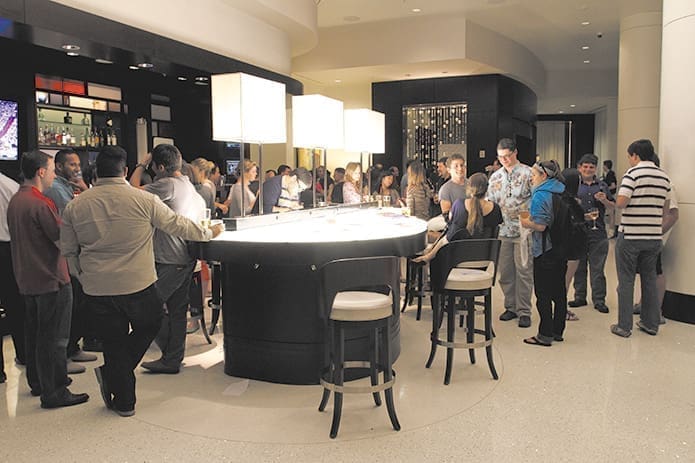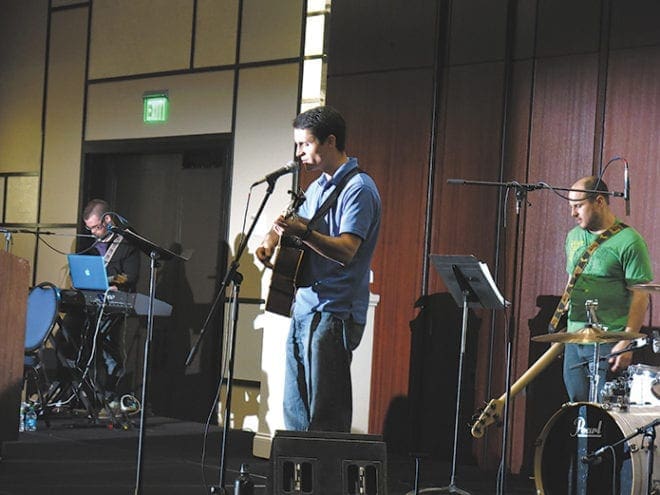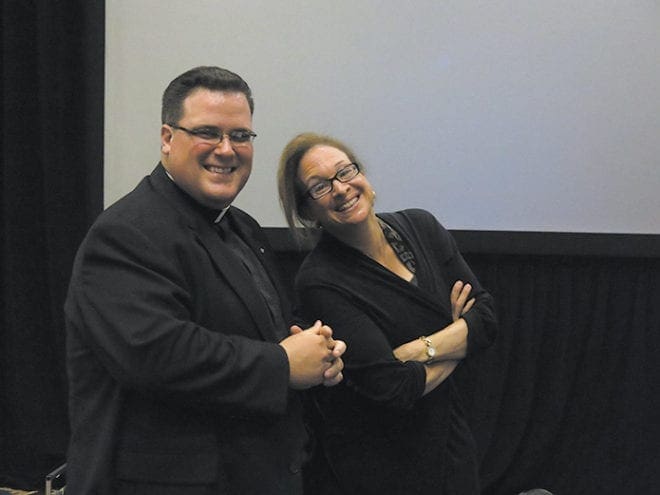 Photo by Michael Alexander
Photo by Michael AlexanderCollege Park
Saints Are Rome’s ‘Treasure,’ Art Historian Says
Published June 6, 2013
COLLEGE PARK—In the ballroom of the Marriott Gateway hotel, Archbishop Carlo Maria Vigano met the future of the church.
Archbishop Wilton D. Gregory brought Archbishop Vigano, the Vatican’s ambassador to the United States, to address hundreds of young adults who attended the annual Revive session of the Eucharistic Congress Friday, May 31.

Jon Ferguson, music minister at St. Catherine of Siena Church, Kennesaw, and his band provide the music for Revive’s young adults at the 2013 Eucharistic Congress. Photo By Mary Anne Castranio
“We are grateful that Archbishop Vigano graciously agreed to be a part of our Eucharistic Congress,” Archbishop Gregory said. “I told him that our young people are full of joy and hope, which bodes well for the future of our church in this part of the country. Archbishop Vigano, I want to introduce you to the future and hope of the Church of Atlanta.”
Archbishop Vigano, an Italian prelate who began serving in the United States in 2011, said the Eucharistic Congress was an opportunity to see “how alive the church is here.”
“Eucharistic Congresses are a very, very important moment for the youth of the church,” he said. “They are an occasion in which we may express our joy that is coming from the faith in our Lord, Jesus Christ.”
Revive featured music by Jon Ferguson and band, and a lively talk from Dr. Elizabeth Lev, an art history professor who has taught in Italy for more than 20 years. Lev used art to describe the lives of revered saints and to encourage others to model their beauty.
Lev focused primarily on images of two young saints, including St. Lawrence, the third-century deacon and martyr who was roasted to death atop a grill.
“St. Lawrence not only changed the world with his martyrdom, but he has inspired artists for generations,” Lev said, adding that Lawrence’s famous quote “I am well done; turn me over,” showed his sense of humor.
“These young saints have a very ready wit. They are Rome’s treasure,” she said.
Showing slides of various paintings and statues of St. Lawrence that can be seen throughout Rome, Lev said he is someone to emulate.
“You can have a poster of Justin Bieber. I’ll take Lawrence,” she joked.
One particular image shows the strength and peace Lawrence possesses, even as he burns.
“We underestimate his sense of serenity. Lawrence is having a far worse day than you and I will ever have. Yet he has this incredible sense of serenity because he knows where he’s going and he knows what he’s doing,” she said. “He shows us how to stay the course, while the rest of us have to slog it out through our daily lives to figure out how to make it to sainthood.”
She then spoke of St. Agnes, who was only 13 when she was martyred for her faith in the early fourth century. After rejecting the governor’s son because she had decided to commit her life to Christ, Agnes was killed in a public arena.
Her story reflects powerfully the freedom that arises from giving one’s life to Christ, Lev said. In an era when women were considered property, this teen had the strength through her Christian faith to do what was unthinkable, she said.
“This guy was a big deal, but Agnes was empowered enough to say ‘this is what I decide.’ I am committed to Christ, the one to whom I am betrothed,” Lev said.
Images throughout Rome portray St. Agnes in various ways.
“What I love about these saints is that they were considered to be very little, but they turn out to be very great,” Lev said. “And nobody remembers the name of the boy (rejected by St. Agnes), when in the story, he’s the important one.”
St. Agnes and St. Lawrence are some of the most popular saints found throughout Rome, with churches, art and buildings bearing their names and likenesses. Lev said she is particularly fond of the statues of these two saints.
“Statues have a sense of doing, of being, of acting,” she said. “They provide a perfect metaphor for what we, as the faithful, are supposed to do.”
Like the saints, our lives, too are “beautiful works of art,” she said.
“Each decision these artists made, they were hammering away, chiseling away, every motion, every brush stroke was creating these beautiful lives,” she said. “Every one of you has the possibility within you to make your life a spectacular work of art.”

Father Joshua Allen, parochial vicar at St. Brigid Church, Johns Creek, poses for a photo with Elizabeth Lev, Ph.D., who was the main speaker for Revive. Photo By Mary Anne Castranio
Following Lev’s talk, Father Michael Silloway, chaplain at St. Pius X High School in Atlanta, brought in the Blessed Sacrament, as those in attendance knelt.
“It’s a powerful image to think of the Lord wanting to make our lives his masterpiece,” Father Silloway said. “I think of that block of marble—dirty and rustic. But the artist would chisel, with big chunks coming off, and then he would use the finer tools to bring out the great details. As young adults, the Lord wants us to recognize that we’re that big block of marble on the workbench of a divine artist. He’s breaking off chunks of sin, pride and arrogance. We’re in the hands of someone who knows exactly what he’s doing.”
Rachel Marder, a 19-year-old parishioner of St. John Neumann Church in Lilburn, said she found Revive “really awesome.”
“I really liked (Lev’s) talk. Thinking of God as the creator, or the painter, it made me think of how we talk about God as the potter and us as the clay,” she said. “I think that’s a powerful image.”
Nina Emamifar, 21, a student at the University of Georgia, said she came to Revive because a friend invited her.
“It was great to see so many other young adults praising God in the Eucharist,” she said. “I also liked the talk. Her using examples of people our age letting God create masterpieces in their lives is really what we should all be striving for.”
Mark Homer, a parishioner of the Cathedral of Christ the King in Atlanta, said he looks forward to the reunion atmosphere every year at Revive. He also said Lev’s talk gave him a new perspective.
“I can really see how the saints’ lives depicted in art is kind of like the mass media back in those days,” he said. “Like anybody, I have my own personal favorite saints, but looking at the paintings and art can really make you see their lives in a new way.”